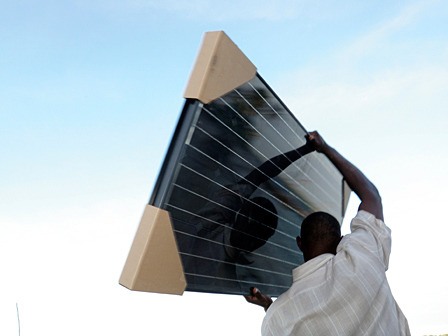The Chole Society for Women Development on Chole Island, Tanzania, was trying to run evening classes for adults and kids needing a little extra help in school. But every dusk left would-be learners in the dark.
In May, Eric Youngren, who owns Island Energy Systems, joined friends at the non-profit SolarAid Tanzania to install and rebuild three different off-grid photovoltaic systems, including the learning center’s, using an invention he has dubbed the “SolarNexus Powercenter.”
“It was a great feeling to install the first SolarNexus Powercenter in Africa!” he wrote in his blog at http://solarnexus.wordpress.com/.
Youngren served as a volunteer with SolarAid, which bought 30 complete solar power systems from Youngren’s company to be installed in Tanzania schools. His girlfriend Golda Moore, a Whidbey Island electrician, also joined the trip.
Youngren first exhibited his powercenter at the Lighting Africa conference, organized by the World Bank and the International Finance Corporation.
After the Nairobi conference, he and Moore headed to Chole, two kilometers square with almost 1,000 residents. The island is part of the Indian Ocean’s Mafia Archipelago, southern neighbors to Zanzibar.
Youngren was fascinated with the archipelago during a trip to Tanzania last year, as many of the islands have no electric grid infrastructure and little chance of getting a grid in the future. SolarAid was also interested in the islands, it turned out, and began dialogue with Chole’s community leaders.
“Our arrival to the island was incredible,” wrote Youngren. “It seemed like the entire community had come out to greet us. The women were dressed in their finest clothes and every kid on the island was there, excitedly looking at the huge pile of equipment that quickly formed on the dock. They had one cart and several bikes to move the batteries on wheels but everything else went on top of a head or in the arms of somebody … two of the sites, the health clinic and the school, had 10-year-old photovoltaic systems that had been installed by a Norwegian NGO but the batteries had all failed.”
The third site was a community center that also served as an open-air market place. SolarAid brought power to the center’s satellite TV just one week before the World Cup competition, allowing the center to sell tickets for viewing.
The team used Youngren’s SolarNexus on the first system at the Learning Center, but then had to build the other two systems by hand, using locally obtained materials.
“The contrast between installing with those materials and the… SolarNexus integration hardware was dramatic,” wrote Youngren. “The locally available materials (terminals, breakers, enclosures, etc.) are just not as appropriate for use in photo-voltaic systems and will not be as efficient or durable as parts designed for those particular applications.”
The team slept at night only with the help of earplugs, thanks to a colony of giant ‘flying fox’ fruit bats that roosted in the trees by their guest house, screeching loudly.
Despite the bat bedlam, Youngren hopes to return to the Mafia Archipelago next year, bringing solar power to remote island communities.
Youngren has been working with solar energy since 2001, forming Island Energy Systems in 2008. He said he aims to run the company as “a triple bottom line business: profit, planet and people.”
“I really believe in the technology,” he said. “Turning sunlight into electricity is like magic; helping people utilize that magic in places where their best other option is running a diesel generator is extremely rewarding.”
SolarAid Tanzania was also recently featured on the BBC’s The World Web site.



